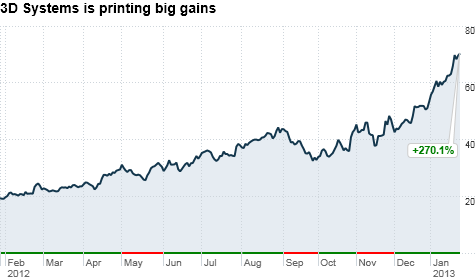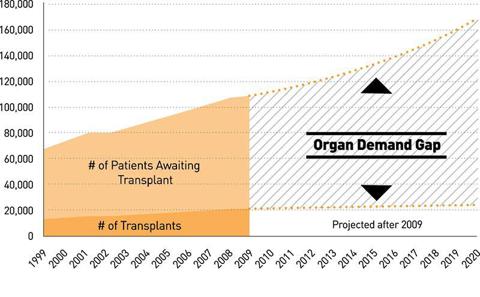Disclosure: I have no positions in any stocks mentioned, and no plans to initiate any positions within the next 72 hours.
Organovo Holdings (ONVO.PK), a creator and manufacturer of three-dimensional human tissue for medical research and therapeutic applications, is working together with researchers at Autodesk (ADSK), a maker of cloud-based design and engineering software, to create the first 3D design software for bioprinting.
The software will be used in conjunction with Organovo's NovoGen MMX bioprinter, and represents an important step in improving usability and functionality for the design of 3D human tissues with the potential to extend the population of bioprinting users. Organovo's 3D bioprinting technology can create living human tissue that is three-dimensional, correct architecturally and composed of living human cells. The tissue can function like native human tissue, and this represents an opportunity for advanced drug discovery and development, and potential surgical therapies and transplants in the future. Autodesk is focused on developing state of the art technology for human-computer interaction, computer graphics and digital design. The bio/nano/programmable matter group is extending this expertise to develop software for the design and simulation of molecules and living systems.
Below, I will explain what 3D bioprinting is, the synergies between Organovo and Autodesk, the potential of 3D bioprinting, and the growing demand for human tissue including organs.
What Is 3D Bioprinting?
Organovo is developing ways to print living human tissue with the objective of producing body parts and implants in a process known as computerized adaptive manufacturing. Custom prototypes and finished parts are produced with the use of affordable 3D computer printers. Instead of extruding plastic, metal or ceramics, these medical printers extrude an ink of living cells. This is called shorthand bioprinting. This is a new use for a standard technology that we are all familiar with in the use of conventional inkjet printers. The printers can create tissue structures, layer by layer, in any 3D shapes, such as tubes, patches of skin and muscle to be used as living Band-Aids.
The Synergy Between Organovo and Autodesk
This is a partnership with a lot of potential. Organovo's NovoGen MMX Bioprinter is a novel, fully automated (custom graphic user interface), hardware and software platform developed specifically to meet the requirements of biological research and bioprinting. From a hardware point of view, it is an extremely powerful tool using state of the art technology, however, it runs on software that is not anywhere near as up to date. Every time a scientist wants to use the printer, the code has to be written from scratch, and this means that the scientist is preoccupied with debugging code instead of advancing research.
Autodesk, the CAD software leader, has become prominent in many professional areas of design, ranging from architecture to industrial design. Virtually anything that has been built in the last two decades may have been designed using Autodesk software, but this is the first time that the company will be working on software that creates living things. The first applications will likely be simple tissues that could be ready for clinical trials in the next five years. Meanwhile, Organovo intends to generate a steady and sustainable revenue stream by producing tissue to be used in drug research, discovery and development.
The Potential Of 3D Bioprinting Technology
The best way to get some idea of the potential of 3-D bioprinting technology is to look at the evolution of other technology that would have been unthinkable even two decades ago. Though the technology is different, the most compelling recent example is the development of tablets and smartphones. What made the leap forward possible was the ability to provide consumers with a multifunctional hand held device that was useful and portable at an affordable price. It was Microsoft (MSFT)which first introduced the Microsoft Tablet PC, the first commercially available tablet in 2002, which was not as successful as had been hoped. It took another eight years before Apple (AAPL) would break technological barriers with the introduction of the iPad in 2010. Today, tablets are selling in the millions and soon expected to overtake laptops and notebooks.
The development of 3D printing has recently become one of the hottest new technologies. 3D printing started as far back as 1984. It took the prevalence of Moore's Law to advance the technology while reducing costs to the point where it made business sense for mainstream companies to utilize 3-D printers. As a result, the market leaders in the 3D printing field, 3D Systems (DDD) and Stratasys (SSYS), have been two of the hottest companies over the last two years. 3-D printing companies have been soaring recently. According to CNN Money, 3D printers were expected to be all the rage at the recent CES gadget trade show in Las Vegas in early January. 3D Systems has already jumped 15% since the beginning of 2013, after seeing a stellar performance in 2012.

The 3D printing industry is expected to see high growth and revenue generation in the near future as more and more companies begin to adopt the technology. Today, giant companies such as Ford (F), Boeing (BA) and GE (GE) are already utilizing 3D printing in their manufacturing operations. According to Brian Mathews, vice-president of Autodesk, "3D printing is a way to re-envision the manufacturing process." Ford uses 3D printing for speed and cost effectiveness in prototyping. Similarly, Boeing has used 3D printing for parts on military aircraft. In November 2012, GE bought privately-owned Morris Technologies, an engineering firm that has heavily invested in 3D printing equipment. The company will be focusing on printing bits for a new range of jet engines.
It is not difficult to see how 3D bioprinting of human tissue including organs could follow the same growth trajectory.
The Demand For 3D Bioprinting Technology
 According to Donate Life America, a U.S. based not-for-profit alliance working toward increasing organ, eye and tissue donation, "Although there have been advances in medical technology and donation, the demand for organ, eye and tissue donation still vastly exceeds the number of donors. The organization also says that "more than 115,000 men, women and children are currently awaiting organ transplants in the United States."
According to Donate Life America, a U.S. based not-for-profit alliance working toward increasing organ, eye and tissue donation, "Although there have been advances in medical technology and donation, the demand for organ, eye and tissue donation still vastly exceeds the number of donors. The organization also says that "more than 115,000 men, women and children are currently awaiting organ transplants in the United States."
CompaniesandMarkets.com is a global aggregator of business information staffed by expert analysts who have authored hundreds of market research reports. According to expert contributor Mike King,
The global artificial organs market is forecast to reach $20 billion by the year 2017, primarily driven by the growing demand among patients for organ transplants. Additionally, technological advancements, cost benefits, an aging population, and scarcity of donor organs are some of the other factors which are expected to fuel demand within the artificial organs market in the upcoming years.
The report also said that artificial pancreas is expected to witness lucrative growth prospects due to 100 million people across the world suffering from diabetes mellitus. Worldwide demand for artificial organs is led by artificial kidneys.
Conclusion
There are other companies working in the field of tissue regeneration and treatment such as Tengion (TNGN), but they are using more conventional technology instead of bioprinting, and none of them have the same focus as Organovo. It could take a long time to profit from the potential of 3D bioprinting and, despite the considerable investment risk, the potential returns could be astronomical.
However, there are favorable short-term price catalysts from the efforts to generate revenues from drug discovery and development. In 2010, Organovo struck a partnership with Pfizer (PFE), under which the company was to earn $450,000 in revenue through the end of 2012. The company has a second agreement with United Therapeutics (UTHR), concluded in October 2011 for a period of 30 months, under which Organovo is utilizing its bioprinting technology to conduct research on treatments for pulmonary hypertension. Organovo has recognized $618,000 in revenues from this deal.
Investors looking at the biotech sector should perform further research on Organovo Holdings to see if it fits within their investment portfolio.


No comments:
Post a Comment